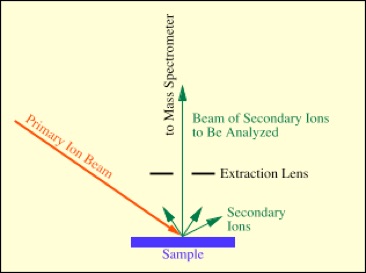SIMS (Secondary Ion Mass Spectrometry) is a measurement technique that can be used for the compositional analysis of small samples. In a SIMS instrument (or “ion microprobe”) a high energy primary ion beam is directed at an area of the sample whose composition is to be determined.

The interaction of the primary ions with the sample surface (“sputtering”) has three major effects: (1) it leads to a mixing of the upper layers of the sample, resulting in an amorphization of the surface; (2) atoms from the primary ion beam are implanted in the sample; and (3) some secondary particles (atoms and small molecules) are ejected from sample.
Among the ejected particles are electrically neutral, as well as positively and negatively charged species. Charged particles of one polarity (“secondary ions”) can then be extracted from the sputtering area with the help of an electrical field between the sample and an extraction lens. These accelerated secondary ions constitute a secondary ion beam which is then led into a mass spectrometer. There, the secondary ions are sorted by mass (and energy) and finally are counted in an ion detector (which can be an electron multiplier, a Faraday cup or a channel plate). The count rates of different secondary ion species give information about the composition of the sample in the sputtered area. Since the size of the sputtered area depends only on the primary ion beam diameter, which typically is on the order of a micrometer, a SIMS analysis has a relatively high lateral resolution.
SIMS can be used for practically all elements of the periodic table, including hydrogen. Only the noble gases are difficult to measure because they don’t ionize easily. SIMS allows the routine measurement of many trace elements at very low concentration (ppb-range). And, since ions of different mass are measured separately, SIMS is ideally suited for the study of the isotopic compositions of small samples.
During a measurement, the sample is slowly sputtered (eroded) away and therefore SIMS is also capable of measuring depth profiles and performing 3-D measurements.
Both of our SIMS instruments, the ims 3f and the NanoSIMS, were made by the same manufacturer, CAMECA. Since much of the research we do makes use of the SIMS instruments, our research pages describe many applications of this technique. Finally, if you work in mass spectrometry, you may find the following files useful:
